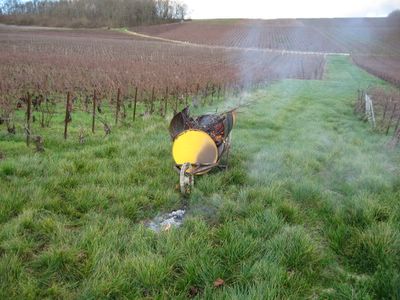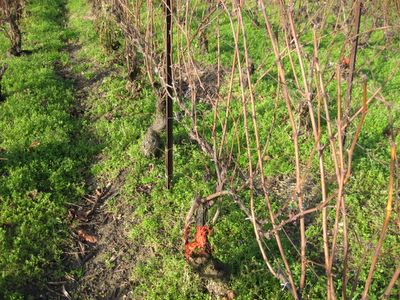 This little vegetable garden at Verzy could be planted with vines instead of pumpkins and sunflowers.
This little vegetable garden at Verzy could be planted with vines instead of pumpkins and sunflowers.Enlarge or not to enlarge.
Much is said and written in the local press, in the professional weeklies, and in meetings for wineprofessionals. Should, should not.
On one hand, it is very important to be able to deliver champagne, when the market is there. On the other it is a bad idea to enlarge, if the customers will not continue to demand still more and more champagne.
No guaranteesGuarantees of course cannot be given. It does take a while to enlarge the supplies of champagne: The vines will only grow the maximum amount of grapes after three years, and on top of that the champagne must age at least 15 months. You've got to be some sort of a gambler.
The chairman of the independent winegrowers, Patrick le Brun, cannot stop repeating - it seems - that there so far is a good margin between the current sales of champagne (317 million bottles the last 12 months) and the amount of bottles that will be sold in two-three yeares (360 million bottles).
But when the INAO-responsible in the champagnecapital of Épernay, Eric Champion, says to the local paper l'Union, that "there are no possibilities of development", because all land is already planted, it still gives second thoughts.
And INAO - the ministerial organisation, that controls the AOC's(Appellation d'Origine Controlée) - is currently working on a report of the possibilites of enlarging the territory.
Work of expertsFive experts - a geologist, a geographer, a historian, an agronomist and a expert in plants have since 2003 examined the land in the communes with vines. The report will contain information about the history of each commune and its suitability as supplier of land to grow vines for champagne. The final result is expected in 2009.
It is expected that the deparment of Aube in Southern Champagne will have quite a few hectares acknowledged to join the appellation. Aube had a lot less than the more known - when it comes to champagne - department of Marne, when some vines were replanted in the 1960'ies.
With the very high prices of land at the moment combined with the very good sales of champagne, it is of course extremely interesting to buy some of these hectares. Rather at
before- than
after-prices.
1.500 difficult hectaresIn the meantime 1.500 hectares, already acknowledged for growing vines for champagne but not used, actually
do exist.
Well, that is, the land is very much in use. As cemeteries, forests or a small vegetable gardens as the picture above shows.
And if you are more into chewing the seeds of sunflowers or eating pumpkins in the long winter, I suppose you are better off with Grand Cru-vegetables than grapes. But each time I pass this place I cannot help thinking: Who is this person, who undauntedly leaves the bubbles to all the others and grows tomatoes, strawberries and pumpkins instead.
På danskCopyright: The copyright for text and photos at bobler.blogspot.com belongs to Solveig Tange. You may use my articles, photos or parts of them for non-commercial use and if I am credited as the author. Feel free to link to this site but not in your own frameset please.


